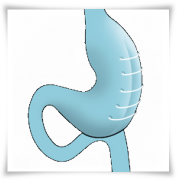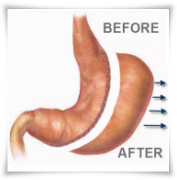Gastric Sleeve vs Gastric Band
A Side-By-Side Comparison
The chart below is a side-by-side comparison of the Gastric Sleeve vs Gastric Band, the two more popular forms of bariatric surgery.
The Gastric Sleeve is also called the laparoscopic sleeve gastrectomy (LSG) and the vertical gastrectomy, and the Gastric Band is also known as the Adjustable Gastric Band.
The information you’ll find in this comparison will give you a general overview of both methods to help you see the similarities and differences between the two procedures.
Click here to compare the Gastric Sleeve vs Gastric Bypass.
Gastric Sleeve vs Gastric Band
| Bariatric Procedure | Gastric Sleeve | Gastric Band |
|---|---|---|
| Approach to Weight Loss |
Restrictive Method - Limits the quantity of food ingested - Controls your hunger by reducing Ghrelin production |
Restrictive Method - Limits the quantity of food ingested - Slows the digestion of food - Improves the patient’s satiety |
| Changes to Stomach | Stomach size is reduced. Up to 85% of the stomach is removed. The greater curvature is taken out of the patient’s body. | Kept Intact. A smaller stomach pouch is created by wrapping a silicone band around the top of the stomach. |
| Medical Implant Required | No | Yes |
| Requires Any Adjustments | No | Yes |
| Average Surgery Time | 1 – 3 hours | 1 hour |
| Average Length of Hospital Stay | 2 – 3 days | 24 hours or less |
| Average Time Off Work Needed | 2 weeks | 1 week |
| Average Recovery Time | 3 weeks | 4-6 weeks |
| Surgery Advantages | - Very safe and simple bariatric surgical procedure - No medical devices are implanted into the body - Will not require adjustments or fills - Very low rate of complications - Does not alter or bypassing the intestines - Hunger is reduced because the area of the stomach which produces Ghrelin is removed - Extemely low risk of malnutrition - Few problematic foods - Is a good option for individuals who don’t qualify for a bypass or a band - Can be converted to a duodenal switch or gastric bypass if additional weight loss is needed - Is a revision option for patients with a gastric band |
- Is the least invasive procedure, and is the least technically complex procedure - Is not permanent, and can be reversed - The band is adjustable to suit any particular patient’s needs - The stomach and intestines are not altered or removed - Can be done on an outpatient basis - Short recovery period after surgery - Extemely low risk of malnutrition - Very low rate of complications |
| Surgery Disadvantages | - General risks of surgery include bleeding, infection, and blood clots - May be leakage along the edge where the stomach has been sutured/stapled - Permanent, and is not reversible - Relatively new development, insufficient long-term data - Procedure is considered investigational and may not be covered by insurance companies |
- General risks of surgery include bleeding, infection, and blood clots - The band may erode over time, slip out of place, or may leak - Port may be displaced or dislodged from its location - Port-site infection - Port/tubing disconnection - Esophageal spasm - Inflammation of the patient’s esophagus or stomach - Gastroesophageal reflux disease (GERD) - Band will require fills and/or adjustments by the doctor - Stoma obstruction |
| Dietary Guidelines | - 600 to 800 calories per day required during the weight loss period - 1000 to 1200 calories per day required to maintain new weight - Eat foods that are high-protein, low-carbohydrate and low-fat - Drink 6 to 8 cups of water or low-calorie liquids each day |
- 800 calories per day required during the weight loss period - 1000 to 1200 calories per day required once the goal weight has been achieved - Eat foods that are rich in protein - Drink 6 to 8 cups of water or low-calorie liquids each day |
| Eating Habits | - Eat 5 small healthy meals every day - Do not eat food and drink liquids at same time - Never overeat, do not skip meals, do not snack between meals |
- Eat 5 small healthy meals every day - Do not eat food and drink liquids at same time - Eat slowly and make sure to chew food thoroughly - Never overeat, do not skip meals, do not snack between meals |
| Problematic Foods | Patient will not encounter many problematic food because the stomach will function normally. High-calorie, high-fat foods and beverages should be avoided. Daily calorie intake must be limited for the weight loss to be successful. | Fibrous foods, dry foods, and doughy foods can cause problems if eaten. High-fat, high-calorie foods must be avoided. Carbonated drinks may cause bloating. |
| Nutritional Supplements | - Calcium - Multivitamin - Vitamin B12 |
- Calcium - Multivitamin |
| Average Weight Loss | - 55% of excess weight is lost after 2 years for all patients - 46% of excess weight is lost for high-risk patients using this as part of a staged approach - 60% of excess weight is lost for patients using this as the primary bariatric treatment |
- A slow, steady rate of weight loss which settles at the final weight 3 – 4 years following surgery - 40% – 50% of excess weight is lost after 1 year - 55% of excess weight is lost after 5 years |
Gastric Sleeve vs Gastric Band
If you are considering weight loss surgery to shed that excess weight, you should be aware that weight loss surgery is but a tool. Everyone is different, so what works for one person may not be the best solution for another person. The best advice would be to speak with your doctor about bariatric surgery and the available options. Get all of the facts, then you can make your own comparison of the Gastric Sleeve vs Gastric Band.


